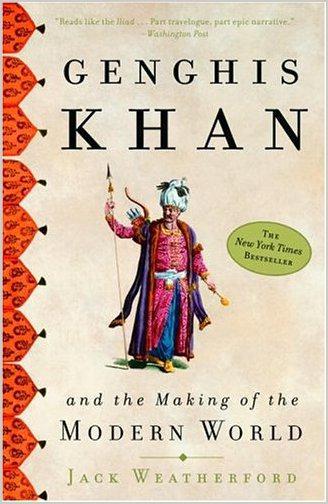Джек Уезерфорд - Genghis Khan and the Making of the Modern World

- Жанр: Наука, Освіта
- Автор: Джек Уезерфорд
Weatherford resurrects the true history of Genghis Khan, from the story of his relentless rise through Mongol tribal culture to the waging of his devastatingly successful wars and the explosion of civilization that the Mongol Empire unleashed.(Goodreads Review)
Шрифт:
Інтервал:
Добавити в закладку:
Contents
Title Page
Dedication
Epigraph
The Mongol Dynasties
Introduction
The Missing Conqueror
PART I
THE REIGN OF TERROR ON THE STEPPE: 1162-1206
1
The Blood Clot
2
Tale of Three Rivers
3
War of the Khans
PART II
THE MONGOL WORLD WAR: 1211–1261
4
Spitting on the Golden Khan
5
Sultan Versus Khan
6
The Discovery and Conquest of Europe
7
Warring Queens
PART III
THE GLOBAL AWAKENING: 1262–1962
8
Khubilai Khan and the New Mongol Empire
9
Their Golden Light
10
The Empire of Illusion
Epilogue
The Eternal Spirit of Genghis Khan
Notes
A Note on Transliteration
Selected Bibliography
Glossary
Acknowledgments
About the Author
Also by Jack Weatherford
Praise for The History of Money
Copyright Page
To the Young Mongols:
Never forget the Mongolian scholars
who were willing to sacrifice their lives to preserve your history.
This noble king was called Genghis Khan,
Who in his time was of so great renown
That there was nowhere in no region
So excellent a lord in all things.
G
EOFFREY
C
HAUCER,
“The Squire’s Tale,”
The Canterbury Tales (c. 1395)
Introduction
The Missing Conqueror
Genghis Khan was a doer.
W
ASHINGTON
P
OST,
1989
IN 1937, THE SOUL of Genghis Khan disappeared from the Buddhist monastery in central Mongolia along the River of the Moon below the black Shankh Mountains where the faithful lamas had protected and venerated it for centuries. During the 1930s, Stalin’s henchmen executed some thirty thousand Mongols in a series of campaigns against their culture and religion. The troops ravaged one monastery after another, shot the monks, assaulted the nuns, broke the religious objects, looted the libraries, burned the scriptures, and demolished the temples. Reportedly, someone secretly rescued the embodiment of Genghis Khan’s soul from the Shankh Monastery and whisked it away for safekeeping to the capital in Ulaanbaatar, where it ultimately disappeared.
Through the centuries on the rolling, grassy steppes of inner Asia, a warrior-herder carried a Spirit Banner, called a sulde, constructed by tying strands of hair from his best stallions to the shaft of a spear, just below its blade. Whenever he erected his camp, the warrior planted the Spirit Banner outside the entrance to proclaim his identity and to stand as his perpetual guardian. The Spirit Banner always remained in the open air beneath the Eternal Blue Sky that the Mongols worshiped. As the strands of hair blew and tossed in the nearly constant breeze of the steppe, they captured the power of the wind, the sky, and the sun, and the banner channeled this power from nature to the warrior. The wind in the horsehair inspired the warrior’s dreams and encouraged him to pursue his own destiny. The streaming and twisting of the horsehair in the wind beckoned the owner ever onward, luring him away from this spot to seek another, to find better pasture, to explore new opportunities and adventures, to create his own fate in his life in this world. The union between the man and his Spirit Banner grew so intertwined that when he died, the warrior’s spirit was said to reside forever in those tufts of horsehair. While the warrior lived, the horsehair banner carried his destiny; in death, it became his soul. The physical body was quickly abandoned to nature, but the soul lived on forever in those tufts of horsehair to inspire future generations.
Genghis Khan had one banner made from white horses to use in peacetime and one made from black horses for guidance in war. The white one disappeared early in history, but the black one survived as the repository of his soul. In the centuries after his death, the Mongol people continued to honor the banner where his soul resided. In the sixteenth century, one of his descendants, the lama Zanabazar, built the monastery with a special mission to fly and protect his banner. Through storms and blizzards, invasions and civil wars, more than a thousand monks of the Yellow Hat sect of Tibetan Buddhism guarded the great banner, but they proved no match for the totalitarian politics of the twentieth century. The monks were killed, and the Spirit Banner disappeared.
Fate did not hand Genghis Khan his destiny; he made it for himself. It seemed highly unlikely that he would ever have enough horses to create a Spirit Banner, much less that he might follow it across the world. The boy who became Genghis Khan grew up in a world of excessive tribal violence, including murder, kidnapping, and enslavement. As the son in an outcast family left to die on the steppes, he probably encountered no more than a few hundred people in his entire childhood, and he received no formal education. From this harsh setting, he learned, in dreadful detail, the full range of human emotion: desire, ambition, and cruelty. While still a child he killed his older half brother, was captured and enslaved by a rival clan, and managed to escape from his captors.
Under such horrific conditions, the boy showed an instinct for survival and self-preservation, but he showed little promise of the achievements he would one day make. As a child, he feared dogs and he cried easily. His younger brother was stronger than he was and a better
Увага!
Сайт зберігає кукі вашого браузера. Ви зможете в будь-який момент зробити закладку та продовжити читання книги «Genghis Khan and the Making of the Modern World», після закриття браузера.


















